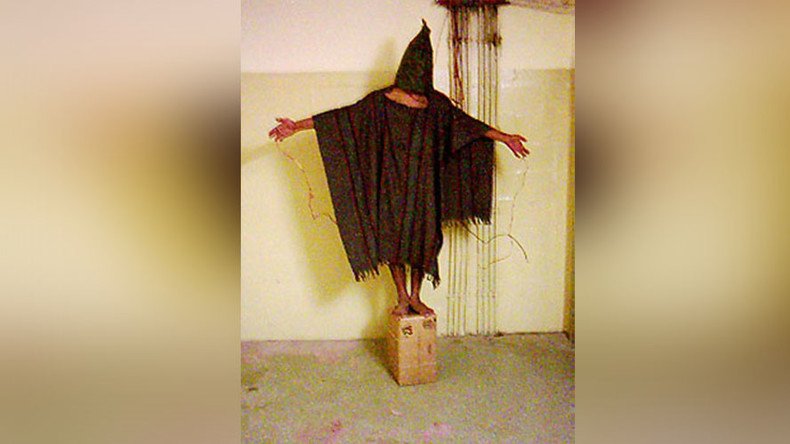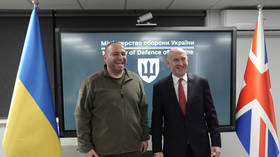CIA forced to release post-9/11 torture evidence, unclear if arrests will follow

Disturbing details of "illegal" torture techniques used by the US government after the 9/11 attacks were revealed by the Central Intelligence Agency (CIA) following a Freedom of Information Act (FOIA) request from the American Civil Liberties Union (ACLU).
More than 800 pages were released Tuesday, which the ACLU says highlights the “inhumanity of the torture conceived and carried out” by the CIA under the George W Bush administration.
New CIA docs (in @ACLU#FOIA case), document torture, crimes for which no senior official has been held accountable https://t.co/2yxkZW2pjN
— Hina Shamsi (@HinaShamsi) June 15, 2016
The documents, some of which have redacted content, were previously seen by the elite group of politicians called the Senate Intelligence Committee as part of its probe into the "enhanced" interrogation program.
“It bears emphasis that these records document grave crimes for which no senior official has been held accountable,” ACLU deputy legal director Jameel Jaffer said.
Referencing the two psychologists contracted by the spy agency to design and implement the torture program, ACLU staff attorney Dror Ladin said, “We’re seeing just how much (James) Mitchell, (John 'Bruce') Jessen, and their CIA co-conspirators knew that what they were doing was wrong and illegal. They talked about seeking a get-out-of-jail-free card for torturing people, and then discussed how to make sure their victims were silenced forever, even if they survived their torture.”
Instead of being convicted for war crimes, some of those responsible occupy powerful positions like federal judge, law professor, and vice president of a defense contractor.
READ MORE: 10 most shocking facts we found in CIA torture report
John Yoo who wrote Bush admin's waterboarding justification rushes to service Trump https://t.co/8qTzn2yKoa +
— Dr.Fatma Ülgen (@fatmaulgen) June 15, 2016
Find myself having to re-read Jay #Bybee's contributions to the #torture memo file & stunned anew that he is (allowed to be) a federal judge
— Katherine Gallagher (@katherga1) March 24, 2016
If Richard Tallman and Jay Bybee are not impeached they will turn court room into crime scenes.
— Wenfo Song (@Wenfo_Song) May 31, 2016
Although some of the details have been previously reported, these documents further detail the gruesome methods used during the lifetime of the covert operation.
Jaffer said in a statement that the files “underscore the cruelty of the methods used in [the CIA’s] secret, overseas black sites.”
Among the gruesome details found in the files is a 35-page internal investigation into the interrogation and death of Gul Rahman known as the “Death Report.”
READ MORE: Torture broke CIA’s own ‘human experimentation’ rules - report
Rahman froze to death in a CIA secret prison in Afghanistan in 2002 after being doused in water and left in a cage semi-naked with no blankets or any form of heat as temperatures dropped below 32 degrees Fahrenheit (0 degrees Celsius).
The same investigation details how “prisoners who possess significant or imminent threat information” were often “stripped to their diapers during interrogation and placed back into their cells wearing only diapers.”
The report goes on to say that if there were no diapers to hand, prisoners were “placed back in their cells in a handcrafted diaper secured by duct tape” or sometimes completely naked.
CIA torture psychologists face court hearing over ‘war crimes’ by black site detainees https://t.co/FxrmnZKI40pic.twitter.com/aQ6RA214Lc
— RT America (@RT_America) April 22, 2016
It is also shown in the files that some CIA employees had objected to some of the techniques being used on the suspects, as well as the legitimacy of their detention.
One memo detailed how a field officer had “serious reservations with the continued use of enhanced techniques” on suspected Al-Qaeda operative Abd al-Rahim al-Nashiri, who remains at Guantanamo Bay today.
‘Mental torture’: #Gitmo inmate testifies against guards at US prison camp https://t.co/v0UoYDMAqk
— RT (@RT_com) June 3, 2016
It’s equally clear, however, that other officers, including those in the higher ranks, found the covert operation to be both effective and within legal bounds.
James L Pavitt, the deputy director for operations at the time, said in a 2004 memo that he believed only an internal probe would confirm the agency’s “fundamental respect for human values.”
Instead of sitting in his own prison cell, Pavitt currently serves on the board of the Scowcroft Group, which is named for the former National Security Advisor for Presidents Gerald Ford and George H.W. Bush.
One “special review” by the CIA found some felt it would be important for the agency to hide the extent of the torture, indicating that relevant detainees should be hidden from representatives of the International Committee of the Red Cross for as long as they live.
I'll say what u all r thinking: these @CIA#torture documents are sick. What sort of psychopaths do this? https://t.co/MeJ9YdEDfP@theCCR
— Wells Dixon (@jwellsdixon) June 15, 2016
CIA torture memo from 2003 approving water-boarding & "use of harmless insects" ht @froomkinhttps://t.co/VHAryx7tzWpic.twitter.com/IbsIQ2nJfL
— Peter Maass (@maassp) June 14, 2016
"Approved for release" - nada. US still in denial. Should investigate & prosecute those responsible for CIA torture https://t.co/8aIht8RY6Z
— Andrew Stroehlein (@astroehlein) June 15, 2016
Another draft letter shows how the CIA applied to the Justice Department, asking the attorney general to “grant a formal declination of prosecution” for any future measures taken by their personnel against Abu Zubaydah. The Al-Qaeda suspect, referred to as AZ, remains at Guantanamo Bay.
The application was made as the methods they intended to use on Zubaydah “normally would appear to be prohibited under the provisions” of the federal law known as the Torture Act.
CIA-tortured Zubaydah called to testify against #Gitmo harsh techniques https://t.co/0cGWSZJQLXpic.twitter.com/8DG5BbvHQG
— RT (@RT_com) May 27, 2016
A number of torture methods have been used against Zubaydah. He was subjected to 83 waterboarding sessions and was placed in a coffin-sized box for a total of 266 hours (11 days, two hours) over a 20-day period.
“All major players are in concurrence that AZ should remain incommunicado for the remainder of his life,” a memo reads.
The use of such interrogation techniques was banned by President Barack Obama in 2009, although presumptive Republican nominee Donald Trump said in February that if he was elected, he would "bring back a hell of a lot worse than waterboarding," echoing his previous sentiments on it.
If America was under the threat of imminent attack, would Obama use torture or a kiss?
— Donald J. Trump (@realDonaldTrump) December 11, 2014
Trump was forced to clarify his remarks in March, however, claiming he would be "bound by laws just like all Americans," but did add that he would "have those laws broadened."
READ MORE: Trump says wouldn’t order ‘illegal’ torture, but expand laws instead












